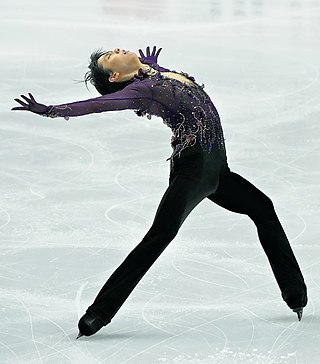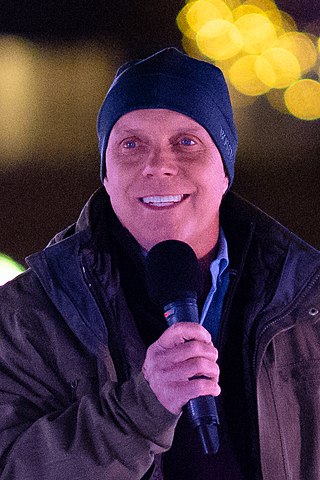| Roy Bradshaw | |||||||||||||||
|---|---|---|---|---|---|---|---|---|---|---|---|---|---|---|---|
| Figure skating career | |||||||||||||||
| Country | |||||||||||||||
Medal record
| |||||||||||||||
Roy Bradshaw is a British figure skater who competed in ice dance.
With partner Susan Getty, he won bronze at the 1971 European Figure Skating Championships in Zurich, Switzerland. [1] [2]
| Roy Bradshaw | |||||||||||||||
|---|---|---|---|---|---|---|---|---|---|---|---|---|---|---|---|
| Figure skating career | |||||||||||||||
| Country | |||||||||||||||
Medal record
| |||||||||||||||
Roy Bradshaw is a British figure skater who competed in ice dance.
With partner Susan Getty, he won bronze at the 1971 European Figure Skating Championships in Zurich, Switzerland. [1] [2]
With Susan Getty
| International | ||||||
|---|---|---|---|---|---|---|
| Event | 1969 | 1970 | 1971 | 1972 | 1973 | 1974 |
| World Championships | 7th | 5th | 4th | |||
| European Championships | 5th | 3rd | ||||
| National | ||||||
| British Championships | 3rd | 1st | 1st | 1st | 1st | |

Figure skating is a sport in which individuals, pairs, or groups perform on figure skates on ice. It was the first winter sport to be included in the Olympic Games, with its introduction occurring at the 1908 Olympics in London. The Olympic disciplines are men's singles, women's singles, pair skating, and ice dance; the four individual disciplines are also combined into a team event, which was first included in the Winter Olympics in 2014. The non-Olympic disciplines include synchronized skating, Theater on Ice, and four skating. From intermediate through senior-level competition, skaters generally perform two programs, which, depending on the discipline, may include spins, jumps, moves in the field, lifts, throw jumps, death spirals, and other elements or moves.

Nancy Ann Kerrigan is an American former figure skater. She won bronze medals at the 1991 World Championships and the 1992 Winter Olympics, silver medals at the 1992 World Championships and the 1994 Winter Olympics, as well as the 1993 US National Figure Skating Championship. Kerrigan was inducted into the United States Figure Skating Hall of Fame in 2004.
The Salchow jump is an edge jump in figure skating. It was named after its inventor, Ulrich Salchow, in 1909. The Salchow is accomplished with a takeoff from the back inside edge of one foot and a landing on the back outside edge of the opposite foot. It is "usually the first jump that skaters learn to double, and the first or second to triple". Timing is critical because both the takeoff and landing must be on the backward edge. A Salchow is deemed cheated if the skate blade starts to turn forward before the takeoff, or if it has not turned completely backward when the skater lands back on the ice.

Scott Scovell Hamilton is a retired American figure skater and Olympic gold medalist. He won four consecutive U.S. championships (1981–84), four consecutive World Championships (1981–84), and a gold medal in the 1984 Olympics. His signature move, the backflip, a feat few other figure skaters could perform at the time, is against U.S. Figure Skating and Olympic competition rules. Yet, he would include it in his exhibition routines as an amateur to please the crowd. Later, he also used the backflip in his professional competition routines. He is widely recognized for his innovative footwork sequences. In retirement, he has been involved in charitable work and is the author of three books.
The Lutz is a figure skating jump, named after Alois Lutz, an Austrian skater who performed it in 1913. It is a toepick-assisted jump with an entrance from a back outside edge and landing on the back outside edge of the opposite foot. It is the second-most difficult jump in figure skating and "probably the second-most famous jump after the Axel".
The toe loop jump is the simplest jump in the sport of figure skating. It was invented in the 1920s by American professional figure skater Bruce Mapes. The toe loop is accomplished with a forward approach on the inside edge of the blade; the skater then switches to a backward-facing position before their takeoff, which is accomplished from the skater's right back outside edge and left toepick. The jump is exited from the back outside edge of the same foot. It is often added to more difficult jumps during combinations and is the most common second jump performed in combinations. It is also the most commonly attempted jump.

The International Skating Union (ISU) is the international governing body for competitive ice skating disciplines, including figure skating, synchronized skating, speed skating, and short track speed skating. It was founded in Scheveningen, Netherlands, in July 1892, making it one of the oldest international sport federations. The ISU was formed to establish standardized international rules and regulations for the skating disciplines it governs, and to organize international competitions in these disciplines. It is now based in Switzerland.

The U.S. Figure Skating Championships is a figure skating competition held annually to crown the national champions of the United States. The competition is sanctioned by U.S. Figure Skating. In the U.S. skating community, the event is often referred to informally as "Nationals". Medals are currently awarded in four disciplines: men's (boys') singles, ladies' (girls') singles, pair skating, and ice dancing in four colors: gold (first), silver (second), bronze (third), and pewter (fourth) on two levels, senior and junior. Medals were previously given at the novice, intermediate, and juvenile levels. The event is also used to determine the U.S. teams for the World Championships, World Junior Championships, Four Continents Championships, and Winter Olympics, however, U.S. Figure Skating reserves the right to consider other results.

The Russian Figure Skating Championships are a figure skating national championship held annually to determine the national champions of Russia. Medals are awarded in the disciplines of men's singles, ladies' singles, pair skating, and ice dancing on the senior level. The senior competition is typically held in late December. The junior national competition is held separately, generally in February.
The 1981 European Figure Skating Championships was a senior-level international competition held at the Olympia Hall in Innsbruck, Austria from February 3 to 8, 1981. Figure skaters competed for the title of European Champion in the disciplines of men's singles, ladies' singles, pair skating, and ice dancing.
The Axel jump or Axel Paulsen jump, named after its inventor, Norwegian figure skater Axel Paulsen, is an edge jump performed in figure skating. It is the sport's oldest and most difficult jump, and the only basic jump in competition with a forward take-off, which makes it the easiest to identify. A double or triple Axel is required in both the short program and the free skating segment for junior and senior single skaters in all events sanctioned by the International Skating Union (ISU).

Czech Republic competed at the 2018 Winter Olympics in Pyeongchang, South Korea, from 9 to 25 February 2018, with 93 competitors in 13 sports. They won seven medals in total: two gold, two silver and three bronze, ranking 14th in the medal table.
The 1966 Blue Swords was an international senior-level figure skating competition organized in Karl-Marx-Stadt, East Germany. Medals were awarded in the disciplines of men's singles, ladies' singles, pair skating and ice dancing. East German national champion Günter Zöller won the first of his four consecutive Blue Swords titles, defeating Czechoslovakia's Marian Filc and West Germany's Reinhard Ketterer. East Germans swept the ladies' and pairs' podiums, led by Gabriele Seyfert, who won her fourth straight gold medal at the event, and Heidemarie Steiner / Heinz-Ulrich Walther. Annerose Baier / Eberhard Rüger won gold ahead of the Soviet Union's Lyudmila Pakhomova / Aleksandr Gorshkov and British duo Susan Getty / Roy Bradshaw.
Joan Dewhirst was a British figure skater who competed in ice dance.
Catherine "Kay" Morris Robinson was a British figure skater who competed in ice dance.
Michael Robinson is a British figure skater who competed in ice dance.
Mary A. Parry was a British figure skater who competed in ice dancing. With partner Roy Mason, she won bronze at the 1960 European Championships in Garmisch-Partenkirchen, West Germany. Parry and Mason were both members of Birmingham Ice Dance Club and had started competing together by 1955.
Roy Mason was a British figure skater who competed in ice dancing. With partner Mary Parry, he won bronze at the 1960 European Championships in Garmisch-Partenkirchen, West Germany. Parry and Mason were both members of Birmingham Ice Dance Club and had started competing together by 1955.
Susan Getty is a British figure skater who competed in ice dance.
Roy Bradshaw may refer to:
Roy Bradshaw.